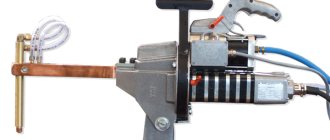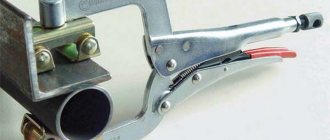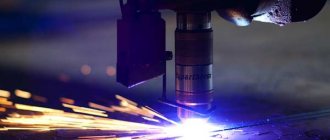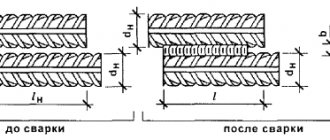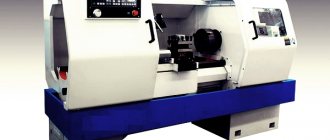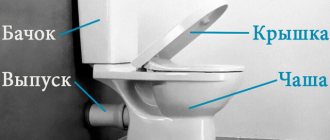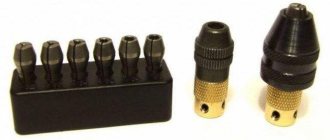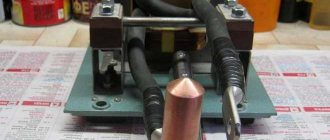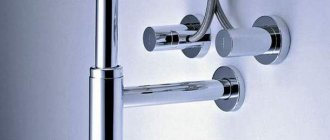Design and principle of operation of products
The method of operation divides such devices into two main types:
- manual;
- hanging.
Diagram of suspended welding jaws.
Hand-held products include a transformer that powers the electrode forceps. The front side of the case is equipped with a lever. It serves to adjust such a parameter as the width to which the holders open. The operation of the entire unit is carried out without the need to connect the electrodes to independent current sources using special wires. These resistance spot welding pliers are practical elements, because their weight is 12 kg.
The production of welding current by the product occurs precisely at the moment when it is connected to the electrical network. This phenomenon is immediately transmitted to the electrodes, with the help of which workpieces made of metal are clamped. Melting of the initial substance is carried out due to the influence of a large amount of welding current, and a welding point is formed in the place where the clamp was located. Excellent adhesion occurs due to the effective action of the electrodes, carried out on both sides simultaneously. The result is a reliable and practical connection that cannot be achieved using single-sided spot welding.
The use of hanging clamps often involves conditions where conventional products may not be suitable. For example, industry requires the availability of serious products, without which processes cannot be carried out. A distinctive feature of many products is their enormous productivity, thanks to which they can be used in completely different production areas.
Design and principle of operation
According to the principle of construction, welding pliers are similar to ordinary pliers, only electrodes are added to the clamping plates, and wires are added to the handles. Welding tongs of any type consist of:
- Current source.
- Trigger mechanism.
- Electrodes.
- Two conductors from pieces of large cross-section cable.
- Swivel lever with clamping mechanism.
To power such a device, a powerful source of electric current is required, which operates at a voltage of 380 V. A conventional transformer, sometimes with a reinforced secondary winding, copes with this function.
An equally important component of the tool for working with resistance welding are electrodes. They are made from copper-based alloys alloyed with chromium, cobalt, cadmium or other chemical elements. Such electrodes have the required strength, heat resistance and fairly low electrical conductivity, which ensures good performance of point connections.
To form a tight welding point with welding pliers, after applying electric current, it is necessary to squeeze the handles of the device with force. For ease of squeezing, the handles of the pliers are often long.
Welding options
Types of spot welding are determined by the number of joint pixels formed at a time. The following types are used in production: single-point, two-point and multi-point types.
The single-point type is used when joining several sheets, while the quality of welding decreases with each layer of sheets (parts). The two-point type of welding is used when connecting parts with wide surfaces.
The multi-point type is used to fasten various stamped structures. It can be bilateral or unilateral, it all depends on the placement of the electrodes in relation to the nodes being fastened.
This type of welding can also differ in the cycles of electrical pulses. The cyclicity depends on the thickness of the parts being welded.
For a metal surface up to five millimeters thick, one pulse of electric current is sufficient, but for large thicknesses, several short-term electrical pulses are necessary. When welding metal elements of great thickness and hardness, cycles with increased compression are used.
Types of devices
In repair shops, workshops, as well as in small assembly lines, manual resistance welding is used. The main role in this process is played by clamping welding pliers, which ensure compression of the workpieces with the necessary force and the flow of electric welding current through them.
Clamping pliers for welding, used in repair and small-scale production, can have the following types of design:
- manual option;
- suspended structure.
Hand pliers are a device that is held in the hands during welding or mounted on a stand. The photo shows the KTR-8 pliers.
Brief list of technical characteristics of KTR – 8:
- The clamps are powered by an industrial single-phase electrical network of 220 Volts;
- the power of the unit is 8 kilovolt-amperes;
- total weight – 14 kilograms;
- the speed of operations reaches 3 welding points in 1 minute with a thickness of two welded sheets of 1.5 millimeters;
- The open circuit voltage of the welding transformer is 2.5 Volts.
After each spot welding, a break of at least 20 seconds is required. The maximum thickness of welded sheet blanks is 1.5 millimeters. The unit is very convenient and easy to use, practically no personnel training is required.
Hand pliers for resistance welding are usually used when joining relatively thin workpieces. In early models, the compression of the workpieces was created by the force of the welder through a lever, as in conventional pliers.
Welding machine
For welding copper wires, any current generator is used: transformer, rectifier, inverter. Resistance welding pliers are connected to car batteries, the two are connected in series, and the contacts are brought out to the electrodes. There is enough power to connect the cable to a 5 mm core. You can’t do a large volume with batteries; you need a welding machine.
Inverter
The advantages of modern inverter devices are obvious:
- they can weld wires of any cross-section;
- they are not afraid of voltage “sagging” in the network, they reduce the risk of electrode sticking and burning of copper strands;
- there are lightweight models that deliver current up to 150–200 A;
- operate from a standard network, no need to connect to three-phase current.
Working with an inverter is easier than working with a transformer. For direct current welding of direct polarity, the plus is connected to the electrode holder, the minus to the copper wire being welded.
Transformer
Bulky old-type devices are difficult to drag from place to place, but transformers are capable of generating current within 400 A. The transformer is suitable for working with direct current of direct or reverse polarity. They are used for welding copper busbars in distribution panels and connecting twisted conductors of large cross-section. The transformer is connected in the same way as an inverter: “+” to the electrode, “-” to the twist. Transformants have good performance, but during operation they hum a lot, get hot, they are periodically turned off and allowed to cool. When turned on, they “sag” the network, but then the voltage stabilizes. When working with a transformer, this should be taken into account.
Based on a step-down transformer with a power of up to 150 A and voltage from 12 to 38 V, you can make a welding machine yourself from household appliances: you need to wind the number of turns of cable around it. You can calculate their number using tables. If you include a diode bridge in the electrical circuit, it will stabilize the arc. The holder can be purchased at the store or a trolleybus contactor clamp can be used instead. Clamping conductive pliers are made from pliers - a contact terminal is screwed to one handle. Be sure to ground the homemade device.
Nutrition
The current source for welding guns is special step-down transformers. The high voltage side is connected to a 380 Volt industrial electrical network, the low voltage winding usually consists of one turn made of a solid copper disk. The secondary winding is designed in such a way that the open circuit voltage is from 2 to 5 Volts.
The current flowing in the secondary winding of the pliers during spot resistance welding can reach values from 2 – 3 kA to 15 kA and higher for different models.
Such transformers are voluminous and quite heavy devices. Despite this, designs in which the transformer is built into a common housing with welding tongs currently predominate.
This is due to the fact that in the case of a separate location of the transformer, it is necessary to ensure its connection with the electrodes through a large cross-section cable.
Such a connection, in addition to being heavy and rigid, causes a noticeable voltage drop in the welding circuit. The weight of the unit can be easily handled by using a suspended structure.
Process technology
To heat the parts to the required temperature, a short-term pulse of high-power electric current is applied to them. As a rule, the pulse lasts from 0.01 to 0.1 seconds (the time is selected based on the characteristics of the metal from which the parts are made).
When pulsed, the metal melts and a common liquid core forms between the parts; until it hardens, the welded surfaces must be held under pressure. Due to this, as it cools, the molten core crystallizes. A drawing illustrating the welding process is shown below.
Spot welding process illustration
Designations:
- A – electrodes;
- B – parts to be welded;
- C – welding core.
Pressure on the parts is necessary so that, when pulsed, a sealing belt is formed along the perimeter of the molten metal core, preventing the melt from flowing outside the zone where welding occurs.
To provide better conditions for crystallization of the melt, the pressure on the parts is gradually removed. If it is necessary to “forge” the welding site in order to eliminate inhomogeneities inside the seam, increase the pressure (do this at the final stage).
Please note that to ensure a reliable connection, as well as the quality of the seam, it is first necessary to treat the surfaces of the parts in the places where welding will take place. This is done to remove oxide film or corrosion.
When it is necessary to ensure reliable connection of parts with a thickness of 1 to 1.5 mm, capacitor welding is used. The principle of its operation is as follows:
- the capacitor block is charged with a small electric current;
- the capacitors are discharged through the parts being connected (the pulse strength is sufficient to ensure the required welding mode).
This type of welding is used in those areas of industry where it is necessary to connect miniature and subminiature components (radio engineering, electronics, etc.).
Speaking about spot welding technology, it should be noted that it can be used to connect dissimilar metals together.
Manual pliers for resistance spot welding
Manual spot welding pliers - the main feature is that it is a small, portable device. The device is cooled in most cases with a rubber hose with a continuous flow of air or cold water. During the welding process, the workpieces are compressed using clamps; on some models, the compression pressure can be adjusted. Hand pliers are often used in construction, industrial production, for the manufacture and repair of automobiles and motorcycles, etc.
Distinctive features of hand pliers
The equipment is produced by many brands: TELWIN, TECNA, BlueWeld, etc. We are official dealers in each of them; prices for devices depend on the popularity of the brand and the technical parameters of the device:
- They are lightweight: from 10 kg in the Blueweld Plus 20/TI model, up to 20 kg in TECNA 7913 devices.
- They work remotely from a heavy transformer and weld small-thickness products from rolled and stamped profiles. Connect round rods with sheets of grade metal, etc. In this case, the process is faster and easier compared to manual arc welding.
- The thickness of the materials being welded varies from 1+1 mm (typical for Blueweld Plus 20/TI and TELWIN MODULAR 20 TI models), to 2+2 mm (for TECNA machines, which also allow joining rods up to 8 mm). The advantage of using hand pliers is mobility and ease of use.
- Possibility of operation from a network with a voltage of 220V or 380V. The budget model Telwin MODULAR 20 TI operates from a single-phase 220V network, with a spot welding current of 3800A. The current value almost doubles on TECNA 7915 devices, but they already operate at 380V.
- They have special fastenings for hanging in workshops during work in order to reduce the load on the worker during welding.
Popular brands
- BRIMA makes the cheapest manual welding guns for resistance welding. The price of the MARS DN-100 model does not exceed 16.5 thousand rubles. - this is the most budget device, it works with metal sheets up to 1.5 mm thick. Therefore, these mites are often used for household purposes.
- The most reliable resistance welding devices from the Italian company TECNA. The equipment is equipped with air cooling, a built-in timer with a semiconductor contactor, which allows you to work with black sheet metal, partially painted and oxidized workpieces.
- TELWIN is an equally famous Italian brand. The company's devices are also equipped with electronic timers. The pliers can change the compression force (in the MODULAR 20 TI model it varies from 40 to 120 kg). But, compared to TECNA devices, the devices are inferior in power.
To buy welding pliers, electrodes and other elements of welding equipment, leave a request on the website. Our managers will call you back and clarify the order details - we know how to optimize your welding process!
Features and principle of spot welding
Let's start studying the question of how to make spot welding with our own hands with the principle of operation.
Today, spot welding is in demand not only in everyday life, but also in production, as it can solve even the most difficult tasks. In industry, as a rule, devices operating in automatic mode are used; in domestic conditions, a semi-automatic welding machine is used for spot welding.
Spot resistance welding in production is necessary to weld sheet blanks from ferrous and non-ferrous metals. It is used to weld products from profiles of different thicknesses and configurations, as well as intersecting metal workpieces. Under some conditions, it is possible to achieve a high-speed operating mode of up to 600 points per minute.
Many people are interested in the question of how to make spot welding at home? In the home environment, spot welding is used to repair household utensils and, if necessary, to weld electrical wires.
The spot welding procedure includes several stages:
- the workpieces are combined in the required position;
- fasten the parts directly between the clamping electrodes of the installation;
- the surfaces are heated, during which the parts are deformed and they bond with each other.
There is another point connection technology - laser welding. It is capable of performing tasks involving high precision work and extreme soldering strength.
It turns out that the principle of spot welding is the excessive heating of working metal surfaces, which results in their fusion and a single structural new formation.
The main role in the welding process is played by the impulse response of the current, which creates the necessary heating of the metal area. An equally important characteristic is the exposure time and the holding force of the parts. Thanks to these parameters, the metal structure crystallizes
The main advantages of electric contact welding from a welding machine are:
- profitability of use;
- strong seam;
- simplicity of equipment;
- homemade spot welding can be created at home;
- possibility of automation in an enterprise environment.
The only flaw in the point connection of parts is considered to be a leaky connection.
The main requirements for welding equipment are:
- the ability to change the process time;
- creating pressure in the working area, reaching the limit at the end of the heating process;
- the presence of electrodes with high energy and heat conductivity.
For household use, electrolytic copper and its mixture of EV grade are suitable. It is worth noting that the area of the contacted area of the electrode must exceed the joint (seam) to be welded by 2.5 times.
Homemade spot welding pliers
But, with some skill and effort, making spot welding pliers with your own hands is not too difficult.
True, in most cases, they belong to a combined type, in which the transformer part and the mechanical part are somewhat separated in space, as, for example, shown in the video: This design is due to the fact that it is quite difficult to make a compact transformer and combine it with clamps in this way , so that the device turns out to be balanced and, at the same time, powerful enough. And balance is very important to achieve high precision welding.
In most cases, home craftsmen build stationary pliers, which are installed on a bed and the part being welded is moved. But in this case, their main property is lost - mobility and the ability to weld in any position.
Successful mechanical solutions for homemade pliers are shown in the photo:
Mechanical homemade pliers
Mechanical homemade pliers
The flight of imagination of amateur designers is unlimited, so on the Internet you can find many very original designs that work no worse, or even better, not at all offensive - it shows that design thought is not limited by the narrow framework of the technical specifications of the enterprise and can work freely.
If spot welding of your own design works in your garage or workshop, share a diagram, photo, video or description with our readers. This will no doubt arouse considerable interest.
Secondary winding
As for the secondary winding, if the clamps were stationary, then 4 turns of wire with a cross-section of 100 sq. mm would be enough. But in this case, since the pliers are remote, the length of the wire from the transformer to the electrodes was 1.7 m. And the longer the wires, the more the power of the device drops.
Unfortunately, I do not know whether the power drop is due to a decrease in secondary current due to thin wires (relative to length) or due to voltage drop during welding. Therefore, I decided to wind 6 turns of 50 sq. mm wire to compensate for the voltage drop during welding.
The pliers were made from a 1/2″ water pipe 50cm long, through which the wires were pulled and bolted directly into the electrodes. Holes were drilled in the electrodes to a depth of 50mm to ensure the largest area of contact between the wire and the electrode. The junction of the pincers is carefully isolated from each other with textolite washers.
The work with the transformer is completed. Now you can start making the body. There was a sheet of 2mm thickness available. It is quite difficult to bend a box made of such thick metal on a sheet bending machine, so grooves were cut in places where the bends were made using a grinder. While the edges are not bent, it is advisable to immediately drill and cut all the necessary holes (fans, sealed leads, etc.).
If there are cuts, bending a thick metal box evenly is not difficult.
Ventilation holes must be provided in the lid. You can simply drill a lot of holes, but this is time-consuming and ugly. Therefore, metal ventilation grilles were purchased, and holes were cut in the lid for these grilles.
Design and types of pliers
Manual welding guns for resistance welding include:
- The housing in which the equipment in question is connected to the welding transformer.
- Swivel arm with clamp for top electrode.
- Bottom electrode clamping unit.
- The handle on which the controls are mounted. For more powerful standard sizes of pliers, pedal activation is provided. The second, side handle is designed to hold the tool during welding.
- Monitoring and control system based on various types of relays - welding current interrupters.
- An extension cord or apron if you need to carry out welding work at some distance from the transformer.
Although the electrodes are not included in the kit, all technical characteristics of the welding pliers produced are based on a specific type and diameter of the consumable. The presence of such a tool significantly reduces the labor intensity of welding, since when working in different places, there is no need to move a massive welding transformer. This is why resistance welding pliers are especially popular in auto repair shops that perform body repair work.
Welding pliers are classified according to the following criteria:
- By installation method. Hanging pliers are popular for industrial resistance electric welding in large volumes, while manual, more compact ones are better for welding in hard-to-reach places.
- By electrode clamping drive, which can be manual or pneumatic.
- According to the drive principle. Automatic pliers are triggered by a control signal from a relay, which turns on when a certain compression force of the electrodes is reached. Mechanized versions are activated by a pedal or by pressing a button on the handle.
- According to the method of cooling the electrode holder. When using high welding currents for contact welding, it is more efficient to use water; in other cases, cooling is carried out using an air jet.
- In terms of performance. Welding tongs with water cooling are capable of ensuring the welder’s work rate at the level of 500...700 points per hour, and tongs with air cooling - no more than 60...70.
A type of welding pliers are spotters - devices that provide manual clamping of electrodes. They are used for resistance welding of small parts.
DIY spot welding machine
The welding machine operates on the principles of the Lenz-Juol law: electric current passing through a conductor releases heat, which is directly equal to the square of the current, time and resistance of the conductor. This means that at a current of 1000 A, on thin wires and poorly made connections, the losses will be 10,000 times greater than at 10 A.
Transformer
The main element of any equipment for spot welding is power, with an increased transformation effect (to obtain a normal welding current). It can be taken in a powerful microwave (from 1 kW and above), it powers the magnetron. Convenient for its availability and good characteristics. The transformer’s performance is sufficient for spot welding 1 mm steel sheets. To obtain more power, use 2 or more parts.
The performance of such transformers is up to 2000 V (in a microwave it doubles before being fed to the magnetron), you should not connect them to the network and measure the output characteristics. From this part we need a primary winding (which has a thicker wire and fewer turns) and a magnetic circuit.
The wires are cut with a chisel or a hacksaw (if it is welded and not glued), or they are picked out and drilled out (if the winding is packed very tightly, when knocking it out will destroy everything). When removing the secondary winding wires, try to act carefully so as not to damage the primary winding. There are also shunts in the transformer that limit the current; they also need to be cut off.
After carefully removing the necessary elements, the secondary winding of the transformer is updated. To achieve current ratings of 1000 A, you need to use a copper cable with a cross-sectional thickness of 100 mm² or more. This can be a bundle or stranded wire. If the external insulation prevents you from obtaining the required number of turns, then it is removed and replaced with fabric insulating tape. The wires should be as short as possible to avoid unnecessary resistance.
make more turns, so you will increase the power indicators
For example, if you have 2 transformers with a power of 0.5 kW, with an input voltage of 220 V, with a rated current of 250 A and an output voltage of 2V. By connecting the terminals of the secondary and primary windings, we get a device in which the rated voltage is 2 V, the output current is 500 A (the welding current will also double).
When creating a device, electrodes must be used in the secondary circuits of the device. That is, when using 0.5 kW transformers, they are connected together with wires with a diameter of 1 cm, and the ends are connected to the electrode. If you make a mistake when connecting the terminals of the secondary and primary windings, this will lead to a short circuit.
When you use two powerful transformers and you need to increase the voltage, but the size of the magnetron window does not allow you to add the required number of turns of wire, for this the secondary windings are connected in series. It is necessary to coordinate the direction of the turns, otherwise you can get antiphase, which will lead to an output voltage equal to zero (to correctly understand this point, conduct an experiment with thin leads).
To the primary windings of transformers
The first case indicates that the circuits of the primary and secondary windings are connected together by opposite terminals (the voltage on the primary winding is equal to half the input, which is converted in the secondary winding, where it is summed up and gives a double value). The zero value of the voltmeter shows that the voltage values on the secondary windings are opposite, which means that one of the pairs of windings is connected by the same terminal.
To increase the performance of your spot welding machine, you need to connect several transformers, but they should not exceed the network performance, otherwise the total voltage will drop when using it. Limit yourself to 1000–2000 A; for domestic conditions, this current strength is sufficient.
Electrodes
Copper rods are used as electrodes. The greater the thickness, the better, but its diameter should not be less than that of the wire. If you have a low-power device, then soldering iron tips will do.
The shorter the wire length
When using crimping, the fastening area is much smaller, which increases losses.
Control
On industrial devices it reaches 100 kg
The switch is connected to the primary winding circuit, otherwise it will add resistance, and its contacts will melt during operation.
If you use a lever clamp mechanism, then mount the shutdown button on it. It is very convenient to press the lever with one hand and control the work. The second hand controls the welding of parts.
Homemade resistance welding pliers
The step-by-step process of assembling spot welding pliers with your own hands will require a little effort and patience. For this we need a copper dart, 2 m long and 30 mm in diameter. The dart can be a little longer so that it can be bent well. We bend it so that we get the letter U. At each end we make one hole with a diameter of 18 mm, unfold them and make a cut. Thus, we will have two clamps for the working electrodes. Next, we connect two transformers in parallel, in which the primary and secondary windings are connected directly, with a voltage of 9 amperes. Adjust the current supply yourself. For example, you can solder a triac switch with an ordinary standby multivibrator, which will work out the shutter speeds. Cooling of homemade ticks is done with water. The electrodes are removed using a foot pedal.
So, manual welding pliers consist of a transformer, a lever that turns the electrodes, and a handle with a pusher. The lever and handle are held by hinges, the axes of which, during operation, are opposite. Some types of pliers have a spring between the pushers. Such pliers are not entirely convenient, since it becomes more and more difficult to compress the spring with any rotation. Every element of the installation is very important. If any component fails, the entire system will collapse.
Working as a spotter
You can also work with thin sheet material using a spotter. This device is mainly intended for welding auxiliary elements to dented car body parts during body repairs.
The use of this technology makes it possible to level damaged body elements whose internal surfaces are difficult to access. In this case, there is no need to dismantle dented body parts.
The spotter is not designed to perform large amounts of welding work. The energy required for resistance welding is stored in a storage capacitor. This allows you to save on the transformer, since its dimensions and weight are much smaller.
But on the other hand, charging the capacitor takes some time, which reduces the “rate of fire” of the device.
Features of choice
Before you decide to buy a tool for resistance welding, you need to know the criteria for choosing a quality unit:
- Operating voltage and current strength. All devices are designed for a specific voltage - 220 V or 380 V.
- Electrode extension is the distance between the electrodes and the unit body. The larger it is, the further from the edge you can weld parts.
- Electrode clamp type. Terminal or threaded.
- Weight of the welding unit.
- Performance.
In addition, it is worth paying attention to the energy consumption of the structure and possible additional properties that do not always add benefits.
Having decided on the specified parameters, as well as having carefully studied the desired modification of the device, you can safely make a purchase.
It has been established that it is more effective to use hand pliers when working with thin sheet metal, and mechanized ones when working with thick sheets.
Hanging model
This type of equipment is used in large repair centers and industrial enterprises with mass production that perform a large number of similar operations.
The most advanced models are equipped with a balanced suspension with a gyroscope, which stabilizes the position of the device in space. The housing houses a powerful transformer current source and an automated control unit that controls the current strength, clamping force and pulse duration.
A productive pneumatic system ensures quick supply of electrodes to the workpiece, clamping with a given force and rapid removal. The pneumatic system is powered from a general workshop compressed air line or from a separate compressor.
The convenient handle allows you to accurately point the device at the welding site and, by pressing a button, give a command for an impulse.
How to work with welding tongs?
The presence of welding pliers eliminates the main problem of resistance welding - the need to supply large current values to the working area while simultaneously ensuring the mobility of the welder. Welding wire is not suitable in such situations, so only electrodes should be used. Special requirements are placed on the housing: it must ensure safe power transmission, reliable fixation of both clamping units and ease of use. Therefore, welding tongs for industrial use are usually equipped with a fastening unit, with which they are attached to the more rigid part to be welded.
Preparation for welding using welding pliers begins with the installation of electrodes in the clamping units. A terminal clamp, which is more reliable, is used more often. The most important characteristic of the equipment is the reach - the distance from the axis of rotation of the movable clamp to the axis of the electrode. The amount of overhang determines the maximum distance from the edge of the welded product. In most equipment designs, the overhang is a variable value and varies within the range of 125...500 mm. This increases the functionality of the device.
The reach can be adjusted smoothly and in steps. In cheaper designs, the amount of overhang is changed by reinstalling the electrode holders into the required grooves or holes on the body. In automatic welding guns, the reach is sometimes adjusted using a plunger that is pulled out using compressed air. However, such devices have not gained popularity among welders: the pliers are becoming heavier, and for stable air supply a receiver is required, which makes the equipment more cumbersome.
Having decided on the amount of overhang, the pliers are installed in the required location and the current supply is turned on. The relay will supply current to the electrodes while providing the required compression force. Having placed the next welding point, turn off the power using a pedal or handle, after which the tool is moved to a new position.
What you need
It is not worth starting to solve such a problem without the necessary theoretical knowledge and practical skills. In words it all looks relatively simple. But if you know how to solder and know how to rewind the transformer coils correctly, you can try it. To do this you will need certain materials and tools.
- Copper wire of a certain cross-section. Its cross-section and quantity can only be determined by performing preliminary calculations.
- Material for making a tire. At worst, you can get by with the same wire, but it is more advisable to purchase a ready-made product.
- Varnish to create an insulating layer on the wires and good insulating tape.
- Multimeter for taking the necessary measurements.
- Soldering supplies – soldering iron, flux, solder, etc.
Of course, you will have to purchase a ready-made welding inverter.
Making pliers
The welding machine for resistance welding is equipped with pliers. Manual pliers for contact joining can be:
- remote;
- stationary.
The second option provides good insulation and perfect contact with the electrodes. To do this, you need to make the remote lever long. It is easier to make handles of the appropriate length on an external structure. The insulation of the moving joint must be reliable; as a rule, washers and bushings made of textolite are used for this.
Resistance welding pliers are manufactured with a specified parameter for the electrode extension in the form of points, which is also important, since the distance from the edge to the place where the parts are joined depends on it. Electrodes are made of copper or beryllium bronze. Welding pliers can also be made from the working part of soldering irons. This is convenient when connecting polyethylene pipes.
A welder on resistance welding machines must be certified, but only if he works in production. Doing spot welding yourself is not a difficult task, just like arc welding. Anyone can do it at home.
With your own hands
Pliers for contact welding of metal are not cheap. The price for both manual and automatic pliers varies from 7-10 thousand rubles and above. But not everyone wants to spend even that amount. In this case, you can make the tool yourself. To do this, you need to follow several steps:
- Form the tongs themselves from metal fittings or thin strips of metal. Place a strong dielectric as the central axis to prevent possible contact shorting.
- Drill holes for mounting electrodes.
- Make or grind the electrodes themselves, for example, use the tips of old soldering irons.
- Stretch and secure the necessary wires to the device. Be sure to use a large cross-section cable.
- Ensure safe operation of the unit. Wrap the handles with insulating material.
- Select a power supply. Any transformer will do for this. You can install two transformers in parallel, which will, in turn, double the power of the unit.
- Make a trigger mechanism. A switch is installed on the body of the hand pliers. Suspended models are characterized by fastening the trigger mechanism to the clamping handle.
- Check all fasteners and connections to ensure the quality of the work done and avoid unpleasant situations.
These explanations for the process of making welding pliers yourself will help you avoid dangerous situations when creating and subsequently working with the structure.
Welding pliers for spot welding are useful equipment that is quite simple in design. Before purchasing, you should carefully study all the characteristics of the selected variety. It must be remembered that a high price does not guarantee the desired quality. A resistance welding unit will be an excellent help in your work, and you can purchase it either in a store or make it yourself from scrap materials.
Hanging model
Hanging tongs for resistance spot welding are used where it is necessary to make a large number of connections per shift. These are usually large repair shops, as well as some assembly lines. The photo shows a TECNA unit
This model of welding tongs is mounted on a special suspension in the welder’s workplace area. The hanging bracket of the device is equipped with a gyroscope to steadily maintain the required spatial orientation.
Inside the housing there is a transformer that generates welding current of the required characteristics and a control unit that allows you to configure the process parameters.
The required compression force of the pliers is achieved through a pneumatic drive. Thus, the pliers are connected by flexible connections to electrical power and a source of compressed air, which can be either an individual or group compressor, or an intra-shop air line. To cool the electrodes during operation, a water system with forced circulation of coolant is used.
The overhead welding gun is controlled using a pistol grip with a trigger attached to the top of the unit. The workpiece is inserted into the gap between the electrodes, then the trigger is pressed, after which the system automatically operates in accordance with the preset settings.
For example, let's look at the technical characteristics of the younger model of welding tongs tecna 3321. Device power (nominal) - 16 kilovolt-amperes.
The maximum power consumption during the welding process is 37 kilovolt-amperes. Power is supplied from a three-phase electrical network of 380 Volts. The voltage value of the secondary winding is 2.8 Volts.
Welding tongs are capable of spot welding steel sheets with a thickness of up to 3 millimeters, or rods with a diameter of up to 10 millimeters. The weight of ticks reaches 52 kilograms. The speed of operations with welding tongs is 3960 points in 1 hour.
In general, the assortment is quite large, so you always have the opportunity to choose the right model.
Ticks
Resistance spot welding pliers: device and principle of operation
The pliers are a manual resistance welding machine used for point joining two overlapping sheets of metal. This is a compact device consisting of two elements:
- transformer;
- a holder for electrodes in the form of forceps attached to the transformer.
The lever compression mechanism can be mechanical (manual), pneumatic or hydraulic.
Connected to the network, the pliers convert the incoming electricity into welding current. It is fed to electrodes in contact with metal workpieces. As a result, a weld point is formed at the point of pressure. The two-sided impact of the electrodes on the metal, compared to one-sided welding, provides better clamping and a more reliable connection.
According to the method of operation, resistance welding pliers are divided into:
- manual. They are lightweight and easy to use. The drive can be either manual or pneumatic;
- mechanized/suspended. Designed for stationary use, weighing more than 100 kg.
Advantages of welding guns
Welding pliers gained popularity among users due to their features:
- small dimensions and weight. Due to their light weight, the pliers are quite easy for the welder to hold during operation. The compact dimensions of the device simplify its transportation and storage;
- a simple welding process that does not require special preliminary preparation;
- reliability and strength of the welded structure without loss of metal properties. The parts being welded are practically not deformed, because thermal effects are limited to the welding zone;
- preservation of primer and anti-corrosion coatings;
- low additional costs, requiring virtually no consumables;
- low energy requirements.
Such devices are in demand in large and small-scale production, service stations, metal repair shops, construction and private household use.
Technical characteristics of welding tongs that are of great importance when choosing
When choosing pliers, be sure to pay attention to the following indicators:
- mains voltage, 220 or 380 V;
- maximum current value. The higher this indicator, the thicker the metal workpieces can be connected;
- thickness of the metal being welded;
- compression mechanism drive and the ability to adjust the applied force;
- length of consoles and the possibility of changing them.
Qualified specialists from the specialized online store “VsyaSvarka.RU” are always ready to help you choose. Our phone number is in Yekaterinburg.
Carefully insulate and cool well
When winding wire onto a coil, be sure to apply insulating varnish to its surface and lay the turns as tightly as possible. Otherwise, interturn short circuits and wire burnout due to overheating cannot be ruled out. Transformer cooling comes to the fore. For some reason, the authors of many articles are silent about this. It is possible that the installation of an additional cooling system consisting of radiators and fans blowing them will be required. If this is not taken care of, the equipment will simply fail due to overheating or even become a fire hazard. As an option, it is possible to install ready-made cooling systems used in electrical and electronics.
Advantages and disadvantages
Resistance welding has quite a lot of advantages, thanks to which it has become so popular recently. First of all, this welding method consumes very little energy with high productivity. After all, the contact connection method is very fast and it takes less than a second to form one weld point. The quality of the resulting seams is at a high level, the connections are strong and durable.
No special knowledge is required; resistance welding can be done by a master without special qualifications. It is also possible to fully automate the work process, up to the point where there is no need to be at the machine. Professional machines can be easily integrated into large assembly lines.
There is also no need to use additional components, such as coated rods, fluxes, gases, etc.
Hence the high environmental friendliness of resistance welding, which is also important in modern production conditions. Another plus is the ease of welding complex metals
You can weld stainless steel, aluminum and non-ferrous metals. There is no need to use inert gas or non-melting rods.
But, like all types of welding, the contact method has its drawbacks. The most important thing is the high price of professional welding equipment. To equip a small plant with the required number of resistance welding machines, you need to have a considerable budget. Not to mention buying a home welding machine.
In addition, such devices are demanding on the power source. They need to produce a large current, at least 1000 amperes. And for this you need a powerful and stable electrical voltage.
Novice welders will probably consider it a disadvantage that the rules for resistance welding are regulated by a separate GOST and they are quite strict. If at least one point from the rule is not observed, then such a part will simply not be accepted for the next production stage. Simply put, you can't avoid work. We do not consider this a disadvantage, because adherence to welding technology and further quality control is the key to a strong and durable metal structure.
Manufacturers of welding guns
Many companies specializing in welding equipment are engaged in the design and production of spot welding pliers. Their arsenal includes both universal manual or suspended models, which can be configured within a fairly wide range, and highly specialized ones, for example, for welding car wheel rims or frame parts. The latter are usually installed as part of conveyor lines.
The most famous manufacturers of pliers are PEI-POINT (Italy), ITS (Russia), FOXWELD (Italy), Dalex Schweißmaschinen, ELMATech GmbH (Germany) and several other international companies.
For household use, you can buy relatively inexpensive Chinese tools that are not very suitable for industrial use, but are quite appropriate in a garage or home workshop. They provide infrequent welding of steel, aluminum, copper and other non-ferrous metals at a fairly high quality level.
Operating principle and design of resistance welding pliers
According to the method of operation, there are two types of pincers for contact connection of parts:
- Manual;
- Hanging.
Hand pliers for a resistance welding machine are a device consisting of a transformer to which pliers for electrodes are attached. At the top of the body there is a lever that performs the function of adjusting the opening width of the holders. To operate the device, it is not necessary to connect the electrodes via wires to a separate current source. These welding guns are very convenient to use, as they weigh only 12 kg.
When connected to an electrical outlet, hand pliers generate a welding current that is supplied to electrodes that clamp metal workpieces. The metal melts under the influence of the welding current, and a welding point is formed at the clamping point. The impact of the electrodes on the metal on both sides provides good clamping, which results in a more reliable connection compared to one-sided spot welding.
Device for joining thicker metal
Welding pliers selection parameters
When choosing manual resistance welding pliers, pay special attention to the maximum current value. The higher the current value, the greater the thickness of the part that can be connected
For a clear example, you can take hand pliers with a current of 3800 A. Using them, we can connect two sheets 1 mm thick. The maximum value of such devices is 6300 amperes. These characteristics allow you to work with sheets up to two millimeters thick each.
An important indicator is the overhang of the electrodes; it is also called the length of the brackets. Electrode extension is the distance from the pliers body to the electrode. The maximum permissible distance from the edge of the sheet at which a point connection can be made depends on this indicator. The length of the brackets, depending on the device model, ranges from 120-500 mm.
Electrodes for resistance welding
No resistance welding can be performed without a specific welding attribute - resistance welding electrodes. The most popular electrodes for contact connection of parts are straight electrodes. They are made from rods with a diameter of 12-40 mm. The tails of electrodes for contact welding are of both cylindrical and conical types. They are fixed in the handle socket using special clamps or conical threaded connections. Welding electrodes with a replaceable working part are secured using a union nut.
Electrodes for resistance welding are made mainly based on copper alloys. Copper is alloyed with chromium, cadmium, beryllium, cobalt, etc. Due to their low electrical resistance and heat resistance, such electrodes do an excellent job when in contact with the surface of the part being welded.
The entire installation is assembled
Types of structures
Resistance welding pliers have a certain classification.
By type of fastening:
- Manual. The compact device consists of a power supply to which electrode forceps are attached. A lever for adjusting the opening of the holders is mandatory. The weight of this design does not exceed 12 kg. Small dimensions allow welding in hard-to-reach places.
- Hanging. They are attached with brackets so that the electrodes are suspended. This allows the welder to process products efficiently and hold only the parts in his hands. Such pliers are in demand in factories for making a large number of weld points.
Hand pliers can also be made hanging. To do this, just fix the bottom handle and leave the top handle free. This method also greatly facilitates the work of the welder, allowing you to leave your hands free.
By drive:
- Automatic. When a certain degree of compression of the handles is reached, the adjustment button is activated.
- Mechanized. They are activated when you press a pedal or button.
By cooling type:
- Vodyanoe. Water-cooled units are efficient at high voltage and can deliver up to 700 points per hour.
- Air. Such designs are used when working with low electric currents, and the productivity is quite low - about 60 points per hour.
You can classify and find differences by clamping the electrodes - manual or pneumatic.
Another type of welding pliers worth noting is the spotter. This is a device for manually clamping electrodes, which allows you to weld small parts.
Types of contact welding
There are several types of resistance welding. These include spot welding (it can be single-point, two-point and multi-point), projection welding, seam welding (can be continuous, stepwise or intermittent), butt welding (performed either by resistance or by fusion). Combinations of different methods are also possible, for example, seam butt welding or relief spot welding. In this case, the combined method will have all the characteristic features of both types of resistance welding.
Let's take a closer look at the methods of contact electric welding of metal products.
Spot welding
Spot welding is the most common type of resistance welding. Its essence is the formation of so-called points by heating the metal and its further deformation. The points are formed in small increments, forming a welded joint.
Spot welding is quite versatile, it is used to join thin sheet metal, small parts used in electrical appliances, and thick parts up to 2 centimeters. Using this method, fast and high-quality welding of stainless steel is possible.
As for the quality and reliability of the connection, everything is simple: the more points, the more reliable the seam. Beginners mistakenly believe that such a connection is unreliable and can break at any moment. But this is a big misconception. A lot of pressure is used to form the point. It easily deforms the heated metal, which then cools and reliably fixes the parts together.
Relief welding
Resistance relief welding is carried out on the same principle as contact welding, only before work the edges of one part are processed using special tools or machines that form protrusions. The part is placed on top, with the protrusions down. The protrusions can be semicircular or oblong. In the place of the protrusion there will be a point formed by the resistance welding machine. The second part remains unchanged, it is placed below.
The relief welding method is often used in automobile assembly. It is very complicated due to the need to form protrusions and is therefore rarely performed at home.
Seam welding
Seam welding is somewhat different from other types of contact welding. Here the electrodes are roller, with their help the metal is not only rolled, but also welded. In this case, the welded joint looks like spot welding. But the dots overlap each other by a few millimeters, forming a seam more like a connection made by hand using a coated electrode.
Seam welding is used when welding thin metals up to 3 millimeters. Seam welding is also excellent for welding sealed products, such as tanks and cisterns.
Butt welding
Resistance butt welding also uses heat and pressure, but in a different plane. The seam is formed not between the upper and lower electrodes, but in the middle. To better understand the concept, look at the diagram below.
Butt welding is divided into resistance welding and fusion welding. In resistance welding, the parts are first joined, then compressed under slight pressure, and only after that a current is supplied to the weld area, which heats the metal, softening it. The metal then cools and a compound is formed.
In fusion welding, parts are preheated to a plastic state and only then connected using pressure. Heating can be either constant, where heat is supplied throughout the entire welding process, or intermittent, where the part is heated at intervals. Intermittent heating is used to save electricity. It is also useful if the parts are small and thin, in such cases there is no need to use heating constantly.
Attentive craftsmen will ask, where does the molten metal disappear? Indeed, with other welding methods, when melting, the metal begins to oxidize and slag is formed. And this creates additional problems. The fact is that in resistance welding, the current has an electrodynamic effect, so it easily throws the molten metal outside the welding zone.
general information
Spot welding clamps come in hand-held and overhead versions. You need to dwell on the types of this tool for a couple of minutes to understand the nuances of their manual assembly.
Manual welding guns have a simple design. Just like all other hand tools (pliers, pliers, forceps), their system is based on a lever that regulates the opening and closing of the pliers.
The main nuance of welding pliers is the ability to use a transformer system. A transformer is connected to one handle of the pliers, which transmits current to the tool in order to create the connection.
Through one of the handles, the transformer mechanism transmits the generated welding current to the electrode rods. This is the main work of the clamping mechanisms. You press metal parts with pliers with your hands, and current flows through them.
